Influence of Adhesive Strength, Fatigue Strength and Contact Mechanics on the Drilling Performance of Diamond Coating
Abstract
1. Introduction
2. Experimental
2.1. Depositing Chemical Vapor Deposition (CVD) Diamond Coating
2.2. Machining Test
3. Results and Discussion
3.1. Characterization of Diamond Coating
3.2. Drilling Performances of the CVD Diamond Coated Micro Drill Bit
3.3. Adhesive Strength and Surface Morphology of Substrate
3.4. Fatigue Strength and Contact Mechanics of Diamond Coating
4. Conclusions
Author Contributions
Funding
Conflicts of Interest
References
- Rani, R.; Panda, K.; Kumar, N.; Titovich, K.A.; Ivanovich, K.V.; Vyacheslavovich, S.A.; Lin, I.N. Tribological properties of ultrananocrystalline diamond films: Mechanochemical transformation of sliding interfaces. Sci. Rep. 2018, 8, 283. [Google Scholar] [CrossRef] [PubMed]
- Xiang, D.; Guo, Z.; Zhang, L.; Feng, H. Preparation and cutting performance of ultra-smooth CVD composite diamond coated ladder-shape drilling tools. Diam. Relat. Mater. 2018, 81, 54–60. [Google Scholar] [CrossRef]
- Abreu, C.S.; Amaral, M.; Fernandes, A.J.S.; Oliveira, F.J.; Silva, R.F.; Gomes, J.R. Friction and wear performance of HFCVD nanocrystalline diamond coated silicon nitride ceramics. Diam. Relat. Mater. 2006, 15, 739–744. [Google Scholar] [CrossRef]
- Abreu, C.S.; Oliveira, F.J.; Belmonte, M.; Fernandes, A.J.S.; Gomes, J.R.; Silva, R.F. CVD diamond coated silicon nitride self-mated systems: Tribological behaviour under high loads. Tribol. Lett. 2006, 21, 141–151. [Google Scholar] [CrossRef]
- Fan, X.; Diao, D. The adhesion behavior of carbon coating studied by re-indentation during in situ TEM nanoindentation. Appl. Surf. Sci. 2016, 362, 49–55. [Google Scholar] [CrossRef]
- Qiu, L.S.; Zhu, X.D.; Lu, S.; He, G.Y.; Xu, K.W. Quantitative evaluation of bonding strength for hard coatings by interfacial fatigue strength under cyclic indentation. Surf. Coat. Technol. 2017, 315, 303–313. [Google Scholar] [CrossRef]
- Baker, C.C.; Chromik, R.R.; Wahl, K.J.; Hu, J.J.; Voevodin, A.A. Preparation of chameleon coatings for space and ambient environments. Thin Solid Films 2007, 515, 6737–6743. [Google Scholar] [CrossRef]
- Almeida, F.A.; Soares, E.; Fernandes, A.J.S.; Sacramento, J.; Silva, R.F.; Oliveira, F.J. Diamond film adhesion onto sub-micrometric WC-Co substrates. Vacuum 2011, 85, 1135–1139. [Google Scholar] [CrossRef]
- Chen, N.; Ai, J.; Chen, Y.; He, P.; Ren, J.; Ji, D. Multilayer strategy and mechanical grinding for smoothing CVD diamond coated defective substrate. Mater. Des. 2016, 103, 194–200. [Google Scholar] [CrossRef]
- Ma, Y.P.; Sun, F.H.; Xue, H.G.; Zhang, Z.M.; Chen, M. Deposition and characterization of nanocrystalline diamond films on Co-cemented tungsten carbide inserts. Diam. Relat. Mater. 2007, 16, 481–485. [Google Scholar] [CrossRef]
- Abreu, C.S.; Amaral, M.S.; Oliveira, F.J.; Tallaire, A.; Benedic, F.; Syll, O.; Cicala, G.; Gomes, J.R.; Silva, R.F. Tribological testing of self-mated nanocrystalline diamond coatings on Si3N4 ceramics. Surf. Coat. Technol. 2006, 200, 6235–6239. [Google Scholar] [CrossRef]
- Shen, B.; Sun, F.H. Deposition and friction properties of ultra-smooth composite diamond films on Co-cemented tungsten carbide substrates. Diam. Relat. Mater. 2009, 18, 238–243. [Google Scholar] [CrossRef]
- Polini, R. Chemically vapour deposited diamond coatings on cemented tungsten carbides: Substrate pretreatments, adhesion and cutting performance. Thin Solid Films 2006, 515, 4–13. [Google Scholar] [CrossRef]
- Liu, M.N.; Bian, Y.B.; Zheng, S.J.; Zhu, T.; Chen, Y.G.; Chen, Y.L.; Wang, J.S. Growth and mechanical properties of diamond films on cemented carbide with buffer layers. Thin Solid Films 2015, 584, 165–169. [Google Scholar] [CrossRef]
- Sun, F.H.; Ma, Y.P.; Shen, B.; Zhang, Z.M.; Chen, M. Fabrication and application of nano-microcrystalline composite diamond films on the interior hole surfaces of Co cemented tungsten carbide substrates. Diam. Relat. Mater. 2009, 18, 276–282. [Google Scholar] [CrossRef]
- Shen, B.; Sun, F.H.; Xue, H.G.; Chen, M.; Zhang, Z.M. Study on fabrication and cutting performance of high quality diamond coated PCB milling tools with complicated geometries. Surf. Eng. 2009, 25, 70–76. [Google Scholar] [CrossRef]
- Shen, B.; Sun, F.H.; Zhang, Z.M.; Shen, H.S.; Guo, S.S. Application of ultra-smooth composite diamond film coated WC-Co drawing dies under water-lubricating conditions. Trans. Nonferr. Met. Soc. 2013, 23, 161–169. [Google Scholar] [CrossRef]
- Lei, X.L.; He, Y.; Sun, F.H. Optimization of CVD diamond coating type on micro drills in PCB machining. Surf. Rev. Lett. 2016, 23, 1550108. [Google Scholar] [CrossRef]
- Polini, R.; Allegri, A.; Guarino, S.; Quadrini, F.; Sein, H.; Ahmed, W. Cutting force and wear evaluation in peripheral milling by CVD diamond dental tools. Thin Solid Films 2004, 469–470, 161–166. [Google Scholar] [CrossRef]
- Almeida, F.A.; Carrapichano, J.M.; Fernandes, A.J.S.; Sacramento, J.; Silva, R.F.; Oliveira, F.J. Nanocrystalline CVD diamond coatings for drilling of WC-Co parts. Int. J. Refract. Met. Hard 2011, 29, 618–622. [Google Scholar] [CrossRef]
- Chen, N.; Shen, B.; Yang, G.; Sun, F. Tribological and cutting behavior of silicon nitride tools coated with monolayer- and multilayer-microcrystalline HFCVD diamond films. Appl. Surf. Sci. 2013, 265, 850–859. [Google Scholar] [CrossRef]
- Chen, N.C.; Sun, F.H. Cutting performance of multilayer diamond coated silicon nitride inserts in machining aluminum-silicon alloy. Trans. Nonferr. Met. Soc. 2013, 23, 1985–1992. [Google Scholar] [CrossRef]
- Dumpala, R.; Chandran, M.; Ramachandra Rao, M.S. Engineered CVD Diamond Coatings for Machining and Tribological Applications. JOM 2015, 67, 1565–1577. [Google Scholar] [CrossRef]
- Arumugam, P.U.; Malshe, A.P.; Batzer, S.A. Dry machining of aluminum–silicon alloy using polished CVD diamond-coated cutting tools inserts. Surf. Coat. Technol. 2006, 200, 3399–3403. [Google Scholar] [CrossRef]
- Prawer, S.; Nemanich, R. Raman spectroscopy of diamond and doped diamond. Philos. Trans. R. Soc. Lond. Ser. A 2004, 362, 2537–2565. [Google Scholar] [CrossRef]
- Ferrari, A.C.; Robertson, J. Origin of the 1150 cm−1 Raman mode in nanocrystalline diamond. Phys. Rev. B 2001, 63, 121405. [Google Scholar] [CrossRef]
- López-Ríos, T. Diamond films studied by surface-enhanced Raman scattering. Diam. Relat. Mater. 1996, 5, 608–612. [Google Scholar] [CrossRef]
- Roy, D.; Barber, Z.H.; Clyne, T.W. Ag nanoparticle induced surface enhanced Raman spectroscopy of chemical vapor deposition diamond thin films prepared by hot filament chemical vapor deposition. J. Appl. Phys. 2002, 91, 6085. [Google Scholar] [CrossRef]
- Knight, D.S.; White, W.B. Characterization of diamond films by Raman spectroscopy. J. Mater. Res. 1989, 4, 385–393. [Google Scholar] [CrossRef]
- Vollath, D.; Fischer, F.D.; Holec, D. Surface energy of nanoparticles—Influence of particle size and structure. Beilstein J. Nanotechnol. 2018, 9, 2265–2276. [Google Scholar] [CrossRef]
- Bouzakis, K.D.; Skordaris, G.; Bouzakis, E.; Makrimallakis, S.; Kombogiannis, S.; Lemmer, O. Fatigue strength of diamond coatings’ interface assessed by inclined impact test. Surf. Coat. Technol. 2013, 237, 135–141. [Google Scholar] [CrossRef]
- Skordaris, G. Fatigue Strength of Diamond Coating-Substrate Interface Quantified by a Dynamic Simulation of the Inclined Impact Test. J. Mater. Eng. Perform. 2014, 23, 3497–3504. [Google Scholar] [CrossRef]
- Johnson, K.L. Contact Mechanics; Cambridge University Press: Cambridge, UK, 1985. [Google Scholar]
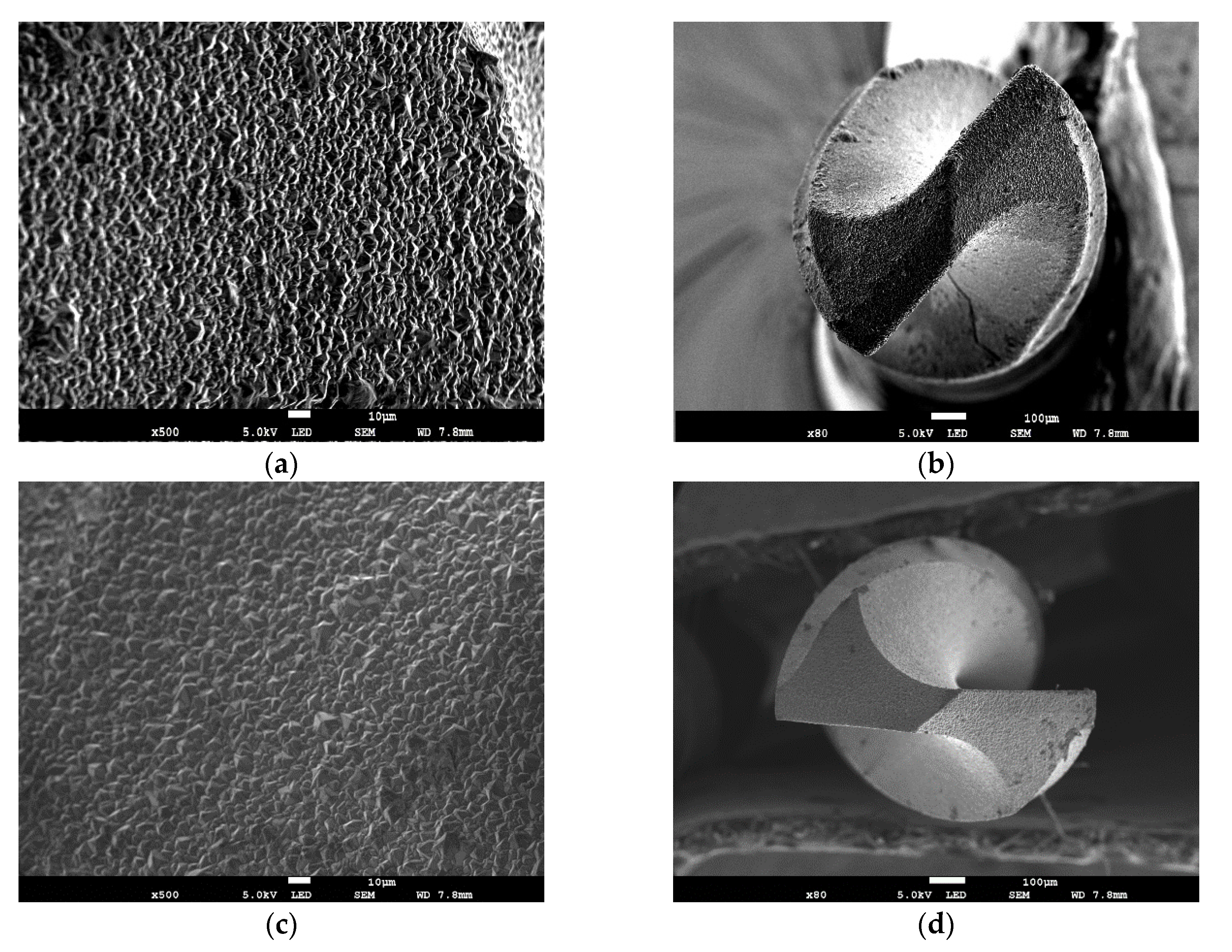
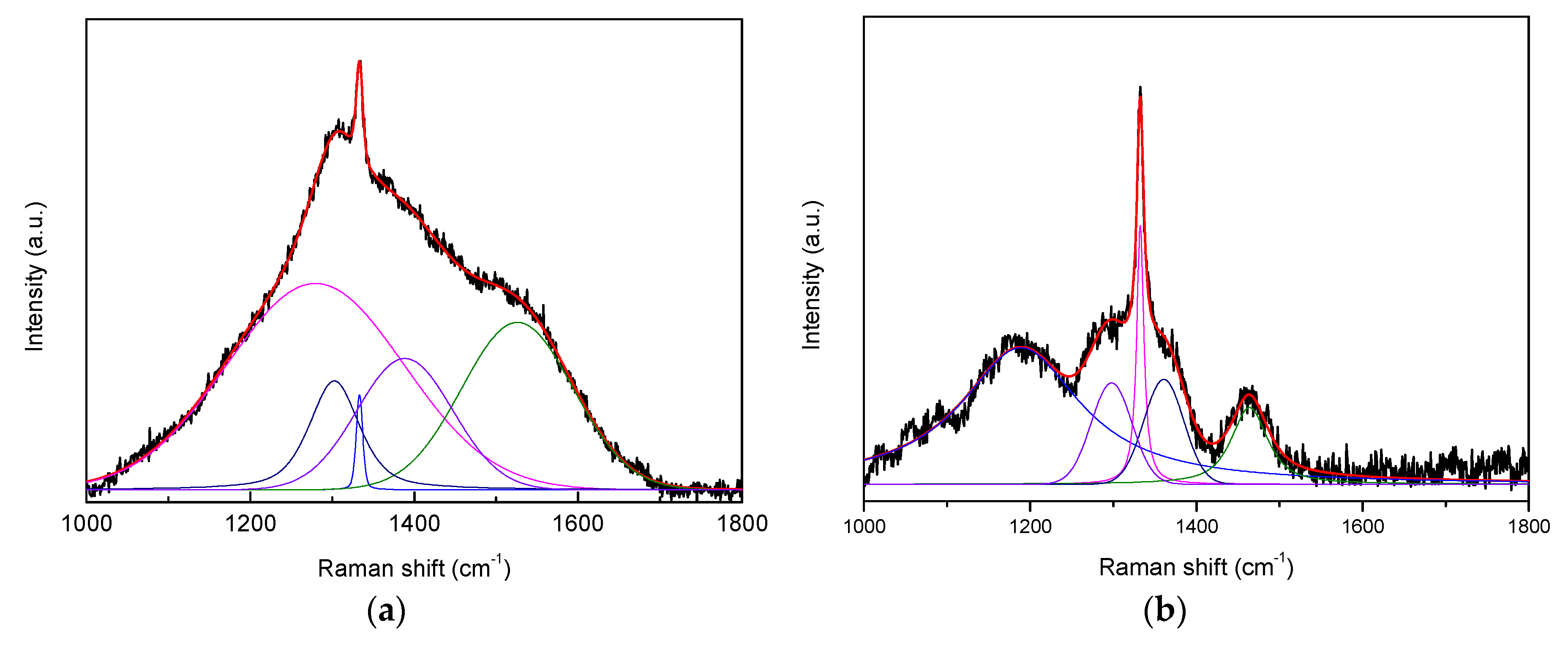


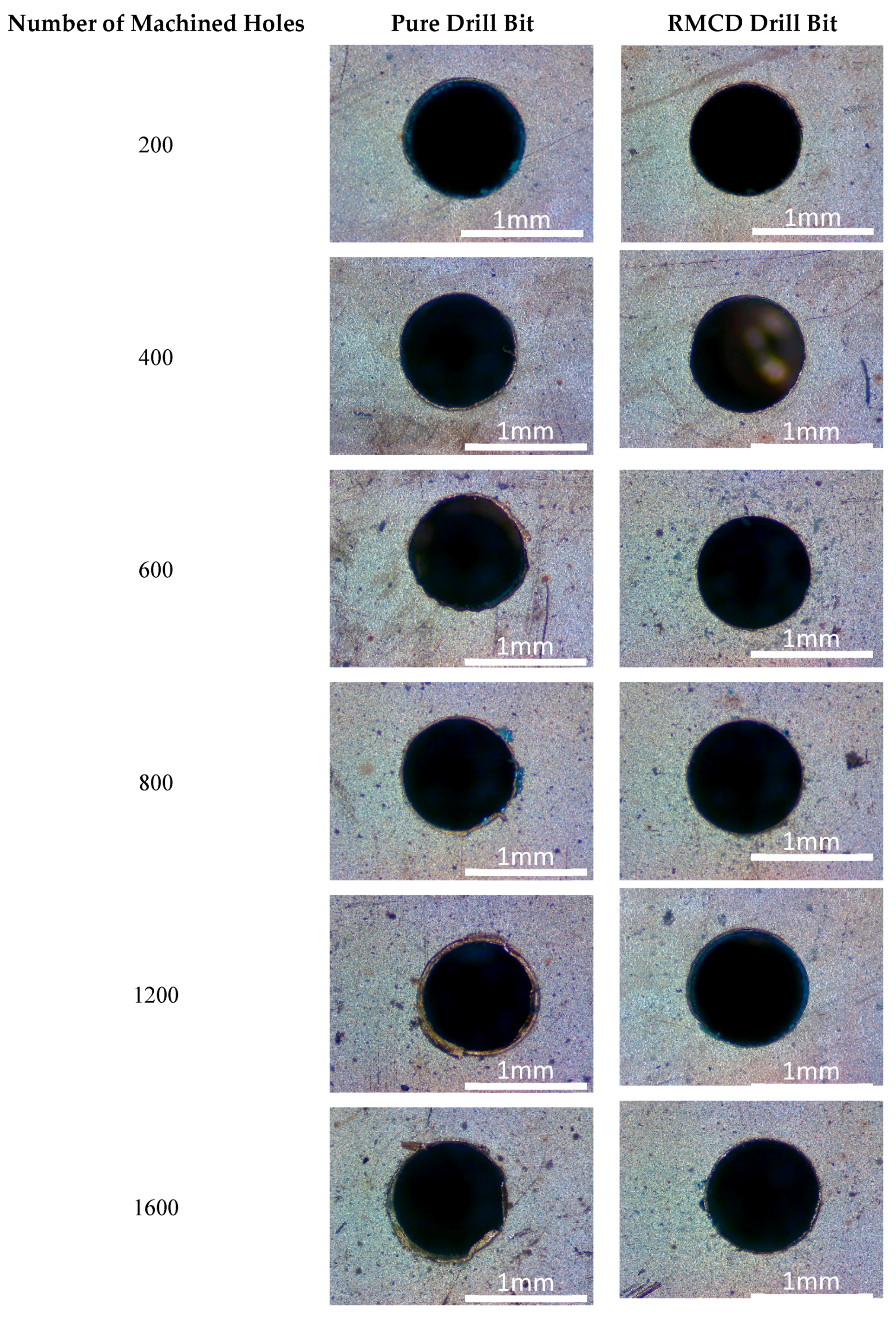
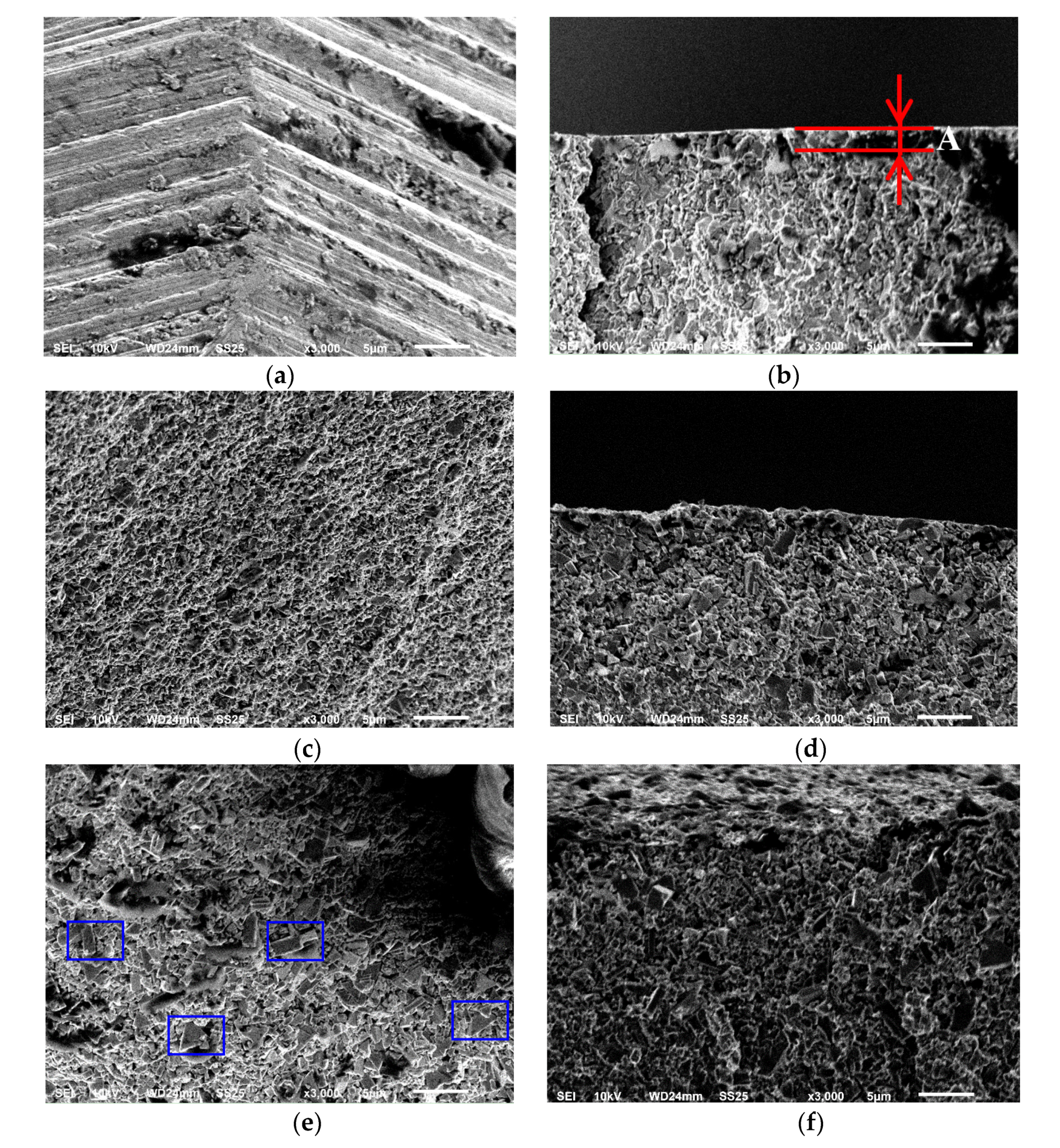
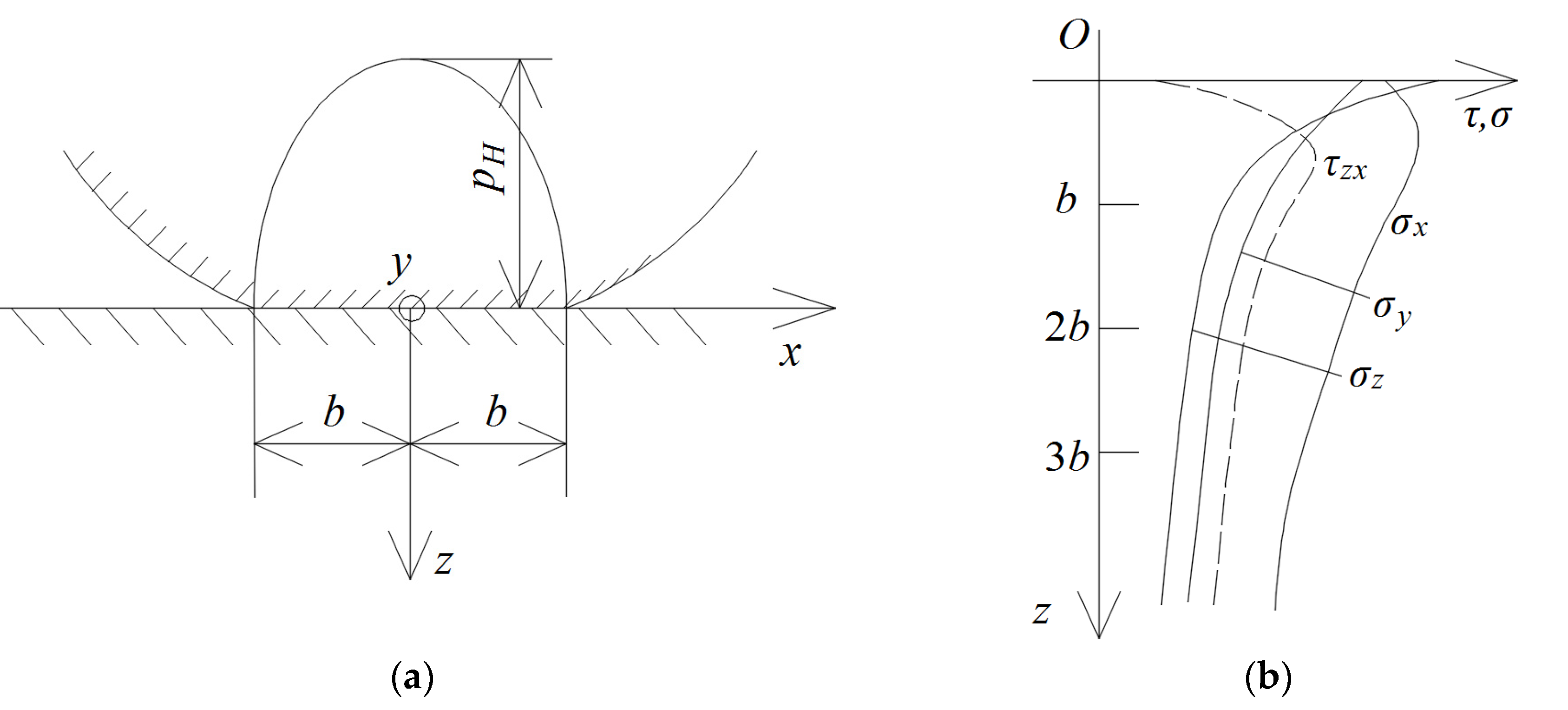

| Item | MCD | |
|---|---|---|
| Nucleation | Growth | |
| Acetone/H2 flow (sccm) | 80/200 | 90/200 |
| Pressure (kPa) | 1.5–2.0 | 4.0–5.0 |
| Bias current (A) | 4.0 | 3.0 |
| Duration (h) | 0.5 | 4 |
© 2020 by the authors. Licensee MDPI, Basel, Switzerland. This article is an open access article distributed under the terms and conditions of the Creative Commons Attribution (CC BY) license (http://creativecommons.org/licenses/by/4.0/).
Share and Cite
Chen, N.; Liu, M.; He, P. Influence of Adhesive Strength, Fatigue Strength and Contact Mechanics on the Drilling Performance of Diamond Coating. Materials 2020, 13, 1402. https://doi.org/10.3390/ma13061402
Chen N, Liu M, He P. Influence of Adhesive Strength, Fatigue Strength and Contact Mechanics on the Drilling Performance of Diamond Coating. Materials. 2020; 13(6):1402. https://doi.org/10.3390/ma13061402
Chicago/Turabian StyleChen, Naichao, Musen Liu, and Ping He. 2020. "Influence of Adhesive Strength, Fatigue Strength and Contact Mechanics on the Drilling Performance of Diamond Coating" Materials 13, no. 6: 1402. https://doi.org/10.3390/ma13061402
APA StyleChen, N., Liu, M., & He, P. (2020). Influence of Adhesive Strength, Fatigue Strength and Contact Mechanics on the Drilling Performance of Diamond Coating. Materials, 13(6), 1402. https://doi.org/10.3390/ma13061402





